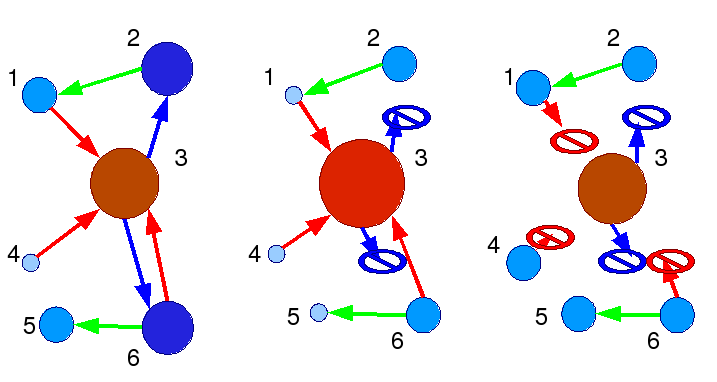Try it out: ingredient based recipe search.
NoFollow Reciprocity
You can first read an introduction to No-Follow.
Because most major web-sites (many of which are build by the community) receive so much PageRank from small sites and don't give any away (by default they use 'rel="nofollow"' attribute in external links), internet is experiencing a capitalization and concentration of a PageRank which is online world equivalent to capital in the 'real' world.

Figure Explanation: Left: Good old web. Middle: Big sites nofollow small ones. Right: Small sites reciprocate.
Note that not only sites that are nofollowed (blue links) lose pagerank which is roughly represented with the size of the circle, but also other sites that are linked to from these (green links). For example, note that even though Page 1 didn't have any link from the big site 3, it did have a link from a smaller site 2 which was affected with the nofollow policy. Effectevely, the whole web is affected, including your site.
IMPORTANT NOTE: Note that since google updated the way it interprets nofollow, placing it on links will not result in the site increasing PageRank (red circle becoming bigger), but it will still result in the target site losing PageRank (blue circle becoming smaller). Read the last Q&A on the bottom of this page for further explanation.
By using nofollow, these sites do not trust external links nor users that post those links. This means that these sites don't give any credit (in the form of PageRank) to those links and are essentially considering them spam (as that was 'officially' the purpose of 'nofollow' tag introduction). This results in their pages appearing higher in search engine results and your pages appearing lower.
Another serious problem with nofollow is that it is a non standard HTML attribute value. This means that most webmasters are not aware of it, and therefore are not applying it. This means that there is no nofollow reciprocity as it is not implemented equally throughout the web. Luckily, this will change with HTML 5, when nofollow will become a part of the standard, and people will learn about it the same way they learn about other HTML elements.
<a href="http://www.example.com/">link</a>
<a href="http://www.example.com/" target="_blank">link with standard attribute</a>
<a href="http://www.example.com/" rel="nofollow">link with non-standard attribute value</a>
Probably every webmaster knows how to place a standard target attribute on a link. This is becuse about every single tutorial on the internet talks about it. I suggested to W3SCHOOLS.COM (one of the best HTML tutorial websites from which I learned HTML) to put a note about rel="nofollow" attribute on their HTML links page, but it seems my suggestion was ignored, even though they use the same on their right sidebar links.
What Now?
We must accept reality. There are few "dofollow movements" on the internet where people suggest eliminating nofollow from blog comments (which is often o.k.), but some suggest that we should never use nofollow, which I think is not a good suggestion. Google is a major discovery tool on the internet - a gateway to world's information (and that's the only reason why I write about this -- wouldn't bother if it was some other search engine, but future is hopeful, as always), and if we want to bring back the balance to the PageRank distribution (and therefore to the access to a more diverse information in search engine results), than we have to apply 'nofollow' towards large websites that use the same. PageRank will remain a significant factor in search engine results for a while, as it proved to be a very successful tool in providing relevant results. However, pagerank distortion leads to distorted results, in my opinion, but you the reader can judge for yourself, based on (the change of?) your personal satisfaction with finding things on Google in the last three years.

Tidak ada komentar:
Posting Komentar